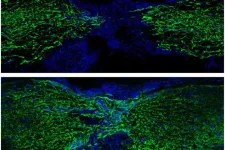(Press-News.org) Alzheimer’s, Parkinson’s, and other neurological disorders can be seen as “dirty brain” diseases, where the brain struggles to clear out harmful waste. Aging is a key risk factor because, as we grow older, our brain's ability to remove toxic buildup slows down. However, new research in mice demonstrates that it’s possible to reverse age-related effects and restore the brain’s waste-clearing process.
“This research shows that restoring cervical lymph vessel function can substantially rescue the slower removal of waste from the brain associated with age,” said Douglas Kelley, PhD, a professor of Mechanical Engineering in the University of Rochester Hajim School of Engineering and Applied Sciences. “Moreover, this was accomplished with a drug already being used clinically, offering a potential treatment strategy.” Kelley is one of the lead authors of the study, which appears in the journal Nature Aging, along with Maiken Nedergaard, MD, DMSc, co-director the University’s Center for Translational Neuromedicine.
First described by Nedergaard and her colleagues in 2012, the glymphatic system is the brain’s unique waste removal process that uses cerebrospinal fluid (CSF) to wash away excess proteins generated by energy hungry neurons and other cells in the brain during normal activity. This discovery pointed the way for potential new approaches to treat diseases commonly associated with the accumulation of protein waste in the brain, such Alzheimer's (beta amyloid and tau) and Parkinson’s (alpha-synuclein). In healthy and young brains, the glymphatic system does a good job of flushing away these toxic proteins, however, as we age, this system slows, setting the stage for these diseases.
A network of tiny pumps draws waste from the brain
Once laden with protein waste, CSF in the skull needs to make its way to the lymphatic system and ultimately the kidneys, where it is processed along with the body’s other waste. The new research combines advanced imaging and particle tracking techniques to describe for the first time in detail the route via the cervical lymph vessels in the neck through which half of dirty CSF exits the brain.
In addition to measuring the flow of CSF, the researchers were able observe and record the pulsing of lymph vessels in the neck that helps draw CSF out of the brain. “Unlike the cardiovascular system which has one big pump, the heart, fluid in the lymphatic system is instead transported by a network of tiny pumps,” said Kelley. These microscopic pumps, called lymphangions, have valves to prevent backflow and are strung together, one after another, to form lymph vessels.
The researchers found that as the mice aged, the frequency of contractions decreased, and the valves failed. As a result, the speed of dirty CSF flowing out of the brains of older mice was 63 percent slower compared to younger animals.
Known drug restarts flow of brain cleaning fluids
The team then set out to see if they could revive the lymphangions and identified a drug called prostaglandin F2α, a hormone-like compound commonly used medically to induce labor and known to aid smooth muscle contraction. The lymphangions are lined with smooth muscle cells, and when the researchers applied the drug to the cervical lymph vessels in older mice, the frequency of contractions and the flow of dirty CSF from the brain both increased, returning to a level of efficiency found in younger mice.
“These vessels are conveniently located near the surface of the skin, we know they are important, and we now know how to accelerate function,” said Kelley. “One can see how this approach, perhaps combined with other interventions, could be the basis for future therapies for these diseases.”
Additional contributors to the study include first authors Ting Du, Aditya Raghunandan, and Humberto Mestre, and Virginia Plá, Guojun Liu, Antonio Ladrón-de-Guevara, Evan Newbold, Paul Tobin, Daniel Gahn-Martinez, Saurav Pattanayak, Qinwen Huang, and Weiguo Peng with the University of Rochester. The research was supported with funding from National Institute of Neurological Disorders and Stroke, the Lundbeck Foundation, the Novo Nordisk Foundation, the Human Frontier Science Program, the Miriam and Sheldon G. Adelson Medical Research Foundation, the Simons Foundation, the EU Joint Programme – Neurodegenerative Disease Research, the US Army Research Office, the National Center for Complementary and Integrative Health, and the BRAIN Initiative.
END
Cleaning up the aging brain: Scientists restore brain's trash disposal system
2024-08-15
ELSE PRESS RELEASES FROM THIS DATE:
Zebrafish use surprising strategy to regrow spinal cord
2024-08-15
Zebrafish are members of a rarefied group of vertebrates capable of fully healing a severed spinal cord. A clear understanding of how this regeneration takes place could provide clues toward strategies for healing spinal cord injuries in people. Such injuries can be devastating, causing permanent loss of sensation and movement.
A new study from Washington University School of Medicine in St. Louis maps out a detailed atlas of all the cells involved — and how they work together — in regenerating the zebrafish spinal cord. In an unexpected finding, the researchers showed that survival and adaptability of the severed neurons themselves is required for full spinal cord regeneration. ...
Bone fracture rates vary dramatically by race
2024-08-15
A new paper in the Journal of Bone and Mineral Research, published by Oxford University Press, finds that bone fracture rates in older women differ by race, quite significantly. While researchers have known for years that the risk of bone fracture is highest for White women, this is the first study to show the real fracture rate for Asian and Hispanic women.
Until recently researchers have had limited data on fracture rates by specific race and ethnicity beyond White people, and even less fracture data within race and ethnic groups. Hispanic and Asian populations are the ...
2024 Shanghai Ranking: Hebrew University rises to 81st, showcasing academic excellence
2024-08-15
For the second consecutive year, three Israeli universities are ranked among the top 100 institutions globally. Alongside the Hebrew University, ranked 81st, are the Technion (85th) and the Weizmann Institute (69th). This is an outstanding achievement for Israeli academia and especially for the Hebrew University.
Professor Asher Cohen, President of the Hebrew University, stated: "The presence of three Israeli universities in the list of the top 100 universities globally is an exceptional achievement in such a challenging and complex year. The Hebrew University's rise to 81st place ...
Neoadjuvant immunotherapy may facilitate surgery and improve outcomes for patients with high-risk liver cancer
2024-08-15
Bottom Line: Patients with liver cancer who received immune checkpoint inhibitors (ICIs) before surgery—including those who would not have been eligible for surgery by conventional criteria—had similar outcomes to patients who received surgery upfront, according to results from a retrospective study.
Journal in Which the Study was Published: Cancer Research Communications, a journal of the American Association for Cancer Research (AACR)
Author: Mari Nakazawa, MD, first author of the study and a clinical research fellow ...
Racial, economic barriers hinder access to medicine for treating opioid use disorder
2024-08-15
PORTLAND, Ore. – Patients with a prescription for an opioid use disorder medication may have a tough time getting it filled if their pharmacy is in a community that’s racially and economically segregated, according to a new study led by scientists at Oregon State University and Johns Hopkins University.
The findings shed additional light on inequities in health care as the U.S.’s overdose crisis continues to accelerate, with fatality rates rising fastest in Black and Hispanic/Latinx communities.
“While there have been notable policy changes over the past decade that ...
Weather and geography drive waterborne infectious disease outbreaks
2024-08-15
An analysis of 12 years of data collected from over 500 hospitals in 25 different U.S. states shows that weather, geographic location, and urban or rural location all appear to influence hospitalizations for waterborne infectious diseases, according to a new study by researchers at Columbia University in the open-access journal PLOS Water.
Waterborne infectious diseases caused by bacteria, parasites, and viruses still affect over 7,000,000 people annually in the United States despite drinking and recreational water regulations, and sanitation ...
First-of-its-kind vaccine expands malaria protection for pregnant women
2024-08-15
August 14, 2024 – In a report published in The Lancet Infectious Diseases (Safety and efficacy of PfSPZ Vaccine against malaria in healthy adults and women anticipating pregnancy in Mali: two randomised, double-blind, placebo-controlled, phase 1 and 2 trials) a team led by investigators at the Malaria Research and Training Center (MRTC), Bamako, Mali; the Laboratory of Malaria Immunology and Vaccinology (LMIV), National Institute of Allergy and Infectious Diseases, National Institutes of Health; and Sanaria Inc. describes ...
Candidate malaria vaccine provides lasting protection in NIH-sponsored trials
2024-08-15
WHAT:
Two National Institutes of Health (NIH)-supported trials of an experimental malaria vaccine in healthy Malian adults found that all three tested regimens were safe. One of the trials enrolled 300 healthy women ages 18 to 38 years who anticipated becoming pregnant soon after immunization. That trial began with drug treatment to remove malaria parasites, followed by three injections spaced over a month of either saline placebo or the investigational vaccine at one of two dosages. Both dosages of the vaccine candidate conferred a significant degree of protection from parasite infection and clinical malaria that was sustained ...
Pioneering research sheds light on how babies and young children understand the art of pretence
2024-08-15
Babies recognise pretence and around half of children can pretend themselves by 12 months, new research has found.
The study, led by the University of Bristol, shows for the first time how children’s awareness and grasp of pretence in its various forms develops from birth to three years.
Lead author Prof Elena Hoicka, Professor of Psychology in Education at the University’s School of Education, said: “Our findings highlight how pretending is a complex, evolving process which begins very early on in life, helping their cognitive and social skills to advance. Pretence ...
Climate reporting standards insufficient, must be expanded, say Oxford net zero experts
2024-08-15
A new paper from the Smith School of Enterprise and the Environment, University of Oxford concludes that current climate standards are not sufficiently incentivising the big picture innovations necessary to deliver net zero, and must be expanded to include a company’s broader influence on climate action. The peer-reviewed research, published in Carbon Management, comes after a period of fierce public debate about climate standards and offers possible solutions for those seeking to improve both integrity and impact of corporate climate action.
Incentivising climate action and innovation in the corporate world is essential says co-author Dr Matilda Becker: “Of the 2000 largest ...


